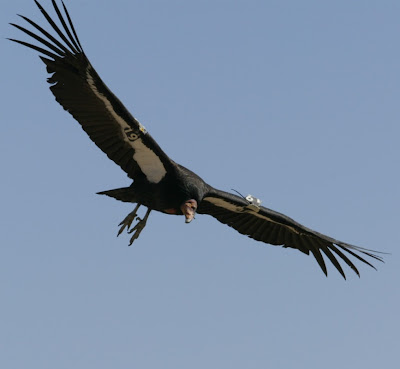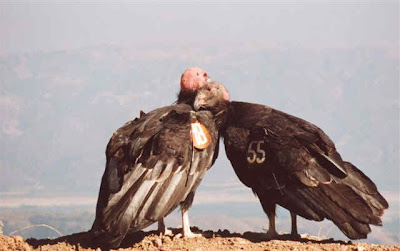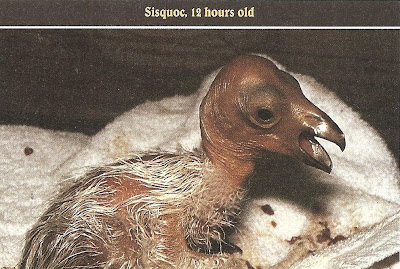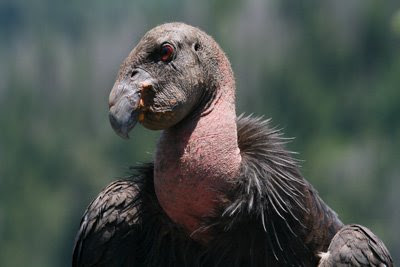 NPS archive
NPS archiveThe California condor is the largest flying land bird in North America. Their wingspan can reach up to 9.5 feet (2.89 m) with bodies 3.5-4.5 feet long (1.06 m-1.37 m). They weigh about 18-23 pounds (8.16-10.43 kg) as they are mostly feathers and have hollow bones like all birds. Plus as they launch into flight they always poop to lighten the load.
 The Condor snuggle NPS archive
The Condor snuggle NPS archiveCondors can live up to 50 years and typically mate for life but not until they’re mature at 6-7 years old. They nest in shallow caves or rocky ledges and lay one egg that both parents tend for about two months. Both parents also raise and feed the chick by regurgitation for almost a year when the juvenile will finally take flight.

NPS archive
For thousands of years condors soared across most of North America. When settlers moved west in the mid-1800s they introduced livestock. Condors can’t kill, but they also don’t know the difference between dead deer or cattle. Unfortunately, the ranchers thought they killed the livestock so in turn shot condors. They put out poisoned carcasses to eliminate predators like wolves, coyotes and bears, and condors ate that also. The population continued to decline when farmers began using DDT on crops in the 1940s. Yet they most commonly die from lead poisoning from eating shot carcasses or gut piles.

NPS archive
During the 1970s a captive breeding program was recommended. But it didn’t happen until 1980 when only 19 birds remained in the wild. The captive breeding program expanded to five facilities and has been very successful. Currently there are 75 California condors flying over Arizona and 320 worldwide plus the possibility of a few new chicks born this year in the wild. They wear radio transmitter tags on a wing and biologists track their movements.
A7
I always feel lucky when I get to see one of these magnificent birds.

Thanks for a very informative article. I liked all the photos you included, especially the ones you got.
Wow that’s a huge one. Fantastic close up view of the birds.
Very interesting post. It is nice to see that these birds are making a comeback. I didn’t know they had such an affinity for people.
How wonderful Gaelyn!! I would be excited too. A beautiful post, thank you.
Such huge majestic birds and so gawky as babies. Wonderful in flight shot.
Ohhhhhhh beautiful (I have a passion for birds of any sort).
The bigger the crowd the more likely there’s something dead to eat.That sentence had me laughing out loud.
I have always wanted to see the North Rim thanks for these awesome photos.
It’s such a thrill to see them in the wild, wouldn’t it be nice if someday it was more a common sight?
Many animals had to go this terrible way of eradication. Not a very good record for the two legged, brainy ones. I guess it was also a battle for survival and education on wildlife was NIL. Thankfully many people today help and try to keep the species going. Education about wildlife has started to seep in, that fauna and flora are precious and have to be protected. The Condor is such a majestic bird and one can barely imagine how beautiful it was to see the birds soaring into the blue sky. Thanks for these great pictures and also the information.
Fascinating post, A7 is a beauty!
Great post and very informative. I was travelling with visitors the other day and we saw an immature eagle in flight and our local host said it was a “turkey vulture”. I politely corrected her and said there are no turkey vultures this far north. “oh but there are” was the retort. “I have lived here all my life and see them every day with the eagles”!
Gaelyn thank you for your very informed post!
Smiles
Great shots. It’s amazing that these birds are making a comeback.
Thats a cool looking bird? Where did you see it on the North Rim?
Wow Gaelyn – that’s awesome. Really interesting post and great photos. As far as the babies – I guess, as they say, that’s a face only a mother could love!
The condors are one of my favorite things to see at the canyon. This was a great post, very informative.
Oh Gaelyn, that’s so cool that you regularly get to see and photograph these awesome birds. Thanks for sharing the information and pictures with us.
Wow. What cool animals!
Wow. What cool animals!
I am so jealous! I need to come see this bird! You are so very fortunate. This is a wonderfully written piece! Are the condors in the canyon year round or do they migrate south like the turkey vultures?
Brilliant post! I saw some of their cousins, the Andean Condor, when I was in Argentina a couple of years ago.
Fantastic post; I was glad to read more about the history of the breeding program. What a honor to be able to see this bird! That is some wingspan.
As it happens, I was on the North Rim on May 19, after hiking through the canyon, and saw the condor make a few passes. Fabulous. What a treat. I shot some video of it. Here’s a link: http://tinyurl.com/kwwcso
Very cool. Also a great reminder that human activity has huge effects on wildlife.
Oh so true about humans impacting wildlife, and the rest of the planet. Wish you were here to see this.